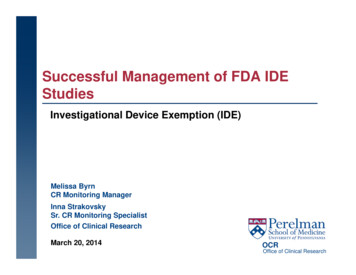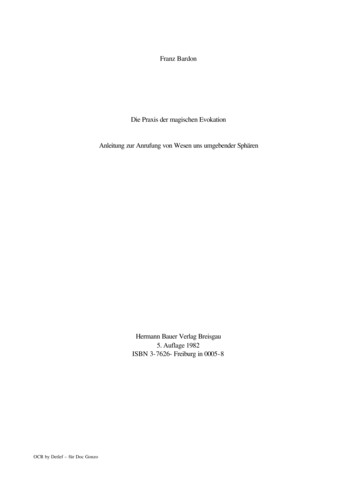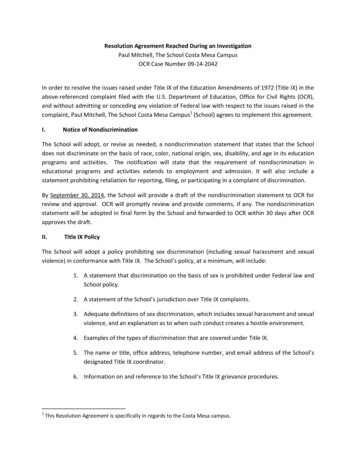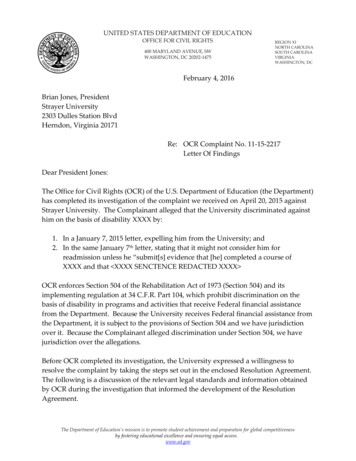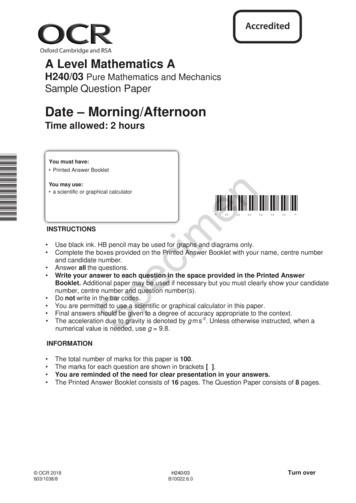
Transcription
A Level Mathematics AH240/03 Pure Mathematics and MechanicsSample Question PaperDate – Morning/AfternoonTime allowed: 2 hoursYou must have:You may use: a scientific or graphical calculatoren Printed Answer Booklet* 00000*SpecimINSTRUCTIONS0Use black ink. HB pencil may be used for graphs and diagrams only.Complete the boxes provided on the Printed Answer Booklet with your name, centre numberand candidate number.Answer all the questions.Write your answer to each question in the space provided in the Printed AnswerBooklet. Additional paper may be used if necessary but you must clearly show your candidatenumber, centre number and question number(s).Do not write in the bar codes.You are permitted to use a scientific or graphical calculator in this paper.Final answers should be given to a degree of accuracy appropriate to the context.The acceleration due to gravity is denoted by g m s-2. Unless otherwise instructed, when anumerical value is needed, use g 9.8.INFORMATION The total number of marks for this paper is 100.The marks for each question are shown in brackets [ ].You are reminded of the need for clear presentation in your answers.The Printed Answer Booklet consists of 16 pages. The Question Paper consists of 8 pages. OCR 2018603/1038/8H240/03B10022.6.0Turn over
2FormulaeA Level Mathematics A (H240)Arithmetic seriesSn 12 n(a l ) 12 n{2a (n 1)d}Geometric seriesa(1 r n )1 raS for r 11 rSn Binomial series(a b)n a n n C1 a n 1b n C2 a n 2b2 n Cr a n r b r bnf ( x)f ( x)tan kxk sec2 kxsec x tan xsec xcotx cosec2 x cosec x cot xcosec xdudvv uu dyQuotient rule y , dx 2 dxv dxvDifferentiation from first principlesf ( x h) f ( x )f ( x) limh 0hIntegrationf ( x)dx ln f ( x) cf ( x) f ( x) f ( x) dx nIntegration by parts1 f ( x) n 1 cn 1 u dx dx uv v dx dxdvduSmall angle approximationssin ,cos 1 12 2 , tan where θ is measured in radians OCR 2018 xSpecimDifferentiationen n n!where n Cr n Cr r r !(n r )!n(n 1) 2n(n 1) (n r 1) r(1 x)n 1 nx x x 2!r!(n ) ,H240/03 1, n
3Trigonometric identitiessin( A B) sin A cos B cos Asin Bcos( A B) cos A cos B sin Asin Btan A tan B1 tan A tan Btan( A B) ( A B ( k 12 ) )Numerical methodsb a y dx 12 h{( y0 yn ) 2( y1 y2 yn 1 ) }, where h Trapezium rule:The Newton-Raphson iteration for solving f( x) 0 : xn 1 xn b anf( xn )f ( xn )ProbabilityP( A B) P( A) P( B) P( A B)orP( A B) Standard deviation2n x2 x 2 orn f x x f2 fx 2 x2 fSpecim x x P( A B)P (B )enP( A B) P( A)P( B A) P( B)P( A B )The binomial distribution n If X B(n, p) then P( X x) p x (1 p)n x , Mean of X is np, Variance of X is np(1 – p) x Hypothesis test for the mean of a normal distribution X 2 N(0, 1)If X N , 2 then X N , andn / n Percentage points of the normal distributionIf Z has a normal distribution with mean 0 and variance 1 then, for each value of p, the table gives the value of zsuch that P(Z z) csMotion in a straight linev u ats ut 12 at 2Motion in two dimensionsv u ats ut 12 at 2v2 u 2 2ass vt 12 at 2s vt 12 at 2s 12 u v t OCR 2018s 12 u v tH240/03Turn over
4Section A: Pure MathematicsAnswer all the questions12(i) If x 3 , find the possible values of 2 x 1 .[3](ii) Find the set of values of x for which 2 x 1 x 1 . Give your answer in set notation.[4](i) Use the trapezium rule, with four strips each of width 0.25, to find an approximate value for11 dx . 0 1 x 2[3]3en(ii) Explain how the trapezium rule might be used to give a better approximation to the integral given inpart (i).[1]In this question you must show detailed reasoning.4SpecimGiven that 5sin 2 x 3cos x , where 0 x 90 , find the exact value of sin x .[4]Show that, for a small angle , where is in radians,1 cos 3cos2 1 52 2 .(i) Find the first three terms in the expansion of 1 px 3 in ascending powers of x.[4]15[3](ii) Given that the expansion of 1 qx 1 px 3 is11 x 92 x 2 .find the possible values of p and q.6[5]A curve has equation y x 2 kx 4 x 1 where k is a constant.Given that the curve has a minimum point when x 2 find the value of k, show that the curve has a point of inflection which is not a stationary point.[7] OCR 2018H240/03
57(i) Find 5 x3 x 2 1 dx .[5](ii) Find tan 2 d .You may use the result8 tan d ln sec c .[5]In this question you must show detailed reasoning.DenC2Specim145 A1E15 30 BThe diagram shows triangle ABC. The angles CAB and ABC are each 45 , and angle ACB 90 . Thepoints D and E lie on AC and AB respectively, such that AE DE 1, DB 2 and angle BED 90 .Angle EBD 30 and angle DBC 15 .(i) Show that BC 2 6.2(ii) By considering triangle BCD, show that sin15 OCR 2018H240/036 2.4[3][3]Turn over
6Section B: MechanicsAnswer all the questions9Two forces, of magnitudes 2 N and 5 N, act on a particle in the directions shown in the diagram below.2N5N11(ii) Calculate the angle between this resultant force and the force of magnitude 5 N.[1]en[3]A body of mass 20 kg is on a rough plane inclined at angle to the horizontal. The body is held at rest onthe plane by the action of a force of magnitude P N acting up the plane in a direction parallel to a line ofgreatest slope of the plane. The coefficient of friction between the body and the plane is .Specim10(i) Calculate the magnitude of the resultant force on the particle.(i) When P 100 , the body is on the point of sliding down the plane.Show that g sin g cos 5 .[4](ii) When P is increased to 150, the body is on the point of sliding up the plane. Using this and youranswer to part (i), find an expression for in terms of g.[3]In this question the unit vectors i and j are in the directions east and north respectively.A particle of mass 0.12 kg is moving so that its position vector r metres at time t seconds is given by r 2t 3i 5t 2 4t j .(i) Show that when t 0.7 the bearing on which the particle is moving is approximately 044 .[3](ii) Find the magnitude of the resultant force acting on the particle at the instant when t 0.7 .[4](iii) Determine the times at which the particle is moving on a bearing of 045 .[2] OCR 2018H240/03
712A girl is practising netball. She throws the ball from a height of 1.5 m above horizontal ground and aims toget the ball through a hoop. The hoop is 2.5 m vertically above the ground and is 6 m horizontally from thepoint of projection.The situation is modelled as follows. The initial velocity of the ball has magnitude U m s 1. The angle of projection is 40 . The ball is modelled as a particle. The hoop is modelled as a point.This is shown on the diagram below.Specim1.5 menU m s-12.5 m6m(i) For U 10, find(a) the greatest height above the ground reached by the ball,[5](b) the distance between the ball and the hoop when the ball is vertically above the hoop.[4](ii) Calculate the value of U which allows her to hit the hoop.[3](iii) How appropriate is this model for predicting the path of the ball when it is thrown by the girl?[1](iv) Suggest one improvement that might be made to this model.[1] OCR 2018H240/03Turn over
813Particle A, of mass m kg, lies on the plane Π1 inclined at an angle of tan 1 34 to the horizontal. Particle B, of4m kg, lies on the plane Π2 inclined at an angle of tan 1 34 to the horizontal. The particles are attached tothe ends of a light inextensible string which passes over a smooth pulley at P. The coefficient of frictionbetween particle A and Π1 is 13 and plane Π2 is smooth. Particle A is initially held at rest such that the stringis taut and lies in a line of greatest slope of each plane.This is shown on the diagram below.PBAenm kg4m kgSpecim(i) Show that when A is released it accelerates towards the pulley at7gm s 2.15(ii) Assuming that A does not reach the pulley, show that it has moved a distance of[6]14m when its speed is7gm s 1.3014[2]A uniform ladder AB of mass 35 kg and length 7 m rests with its end A on rough horizontal ground and itsend B against a rough vertical wall. The ladder is inclined at an angle of 45 to the horizontal. A man ofmass 70 kg is standing on the ladder at a point C, which is x metres from A. The coefficient of frictionbetween the ladder and the wall is 13 and the coefficient of friction between the ladder and the ground is12The system is in limiting equilibrium.Find x.[8].END OF QUESTION PAPERCopyright Information:OCR is committed to seeking permission to reproduce all third-party content that it uses in the assessment materials. OCR has attempted toidentify and contact all copyright holders whose work is used in this paper. To avoid the issue of disclosure of answer-related information tocandidates, all copyright acknowledgements are reproduced in the OCR Copyright Acknowledgements booklet. This is produced for eachseries of examinations and is freely available to download from our public website (www.ocr.org.uk) after the live examination series.If OCR has unwittingly failed to correctly acknowledge or clear any third-party content in this assessment material, OCR will be happy to correctits mistake at the earliest possible opportunity.For queries or further information please contact the Copyright Team, First Floor, 9 Hills Road, Cambridge CB2 1GE.OCR is part of the Cambridge Assessment Group; Cambridge Assessment is the brand name of University of Cambridge Local ExaminationsSyndicate (UCLES), which is itself a department of the University of Cambridge. OCR 2018H240/03
day June 20XX – Morning/AfternoonA Level Mathematics AenH240/03 Pure Mathematics and Mechanicsec100SpMAXIMUM MARKimSAMPLE MARK SCHEMEThis document consists of 20 pagesB10022/6.0Duration: 2 hours
H240/03Mark SchemeText InstructionsMeaningOther abbreviations inmark schemeE1dep*caooerotsoiwwwAGawrtBCDRMeaningBenefit of doubtFollow throughIgnore subsequent workingMethod mark awarded 0, 1Accuracy mark awarded 0, 1Independent mark awarded 0, 1Special caseOmission signMisreadimAnnotation in scoris and BODFTISWM0, M1A0, A1B0, B1SC MRHighlightingen1. Annotations and abbreviationsSpecMark for explaining a result or establishing a given resultMark dependent on a previous mark, indicated by *Correct answer onlyOr equivalentRounded or truncatedSeen or impliedWithout wrong workingAnswer givenAnything which rounds toBy CalculatorThis question included the instruction: In this question you must show detailed reasoning.2June 20XX
H240/03Mark SchemeJune 20XX2. Subject-specific Marking Instructions for A Level Mathematics AAnnotations should be used whenever appropriate during your marking. The A, M and B annotations must be used on your standardisation scripts forresponses that are not awarded either 0 or full marks. It is vital that you annotate standardisation scripts fully to show how the marks have been awarded.For subsequent marking you must make it clear how you have arrived at the mark you have awarded.bAn element of professional judgement is required in the marking of any written paper. Remember that the mark scheme is designed to assist in markingincorrect solutions. Correct solutions leading to correct answers are awarded full marks but work must not be judged on the answer alone, and answersthat are given in the question, especially, must be validly obtained; key steps in the working must always be looked at and anything unfamiliar must beinvestigated thoroughly. Correct but unfamiliar or unexpected methods are often signalled by a correct result following an apparently incorrect method.Such work must be carefully assessed. When a candidate adopts a method which does not correspond to the mark scheme, escalate the question to yourTeam Leader who will decide on a course of action with the Principal Examiner.If you are in any doubt whatsoever you should contact your Team Leader.cThe following types of marks are available.imenaecMA suitable method has been selected and applied in a manner which shows that the method is essentially understood. Method marks are not usually lostfor numerical errors, algebraic slips or errors in units. However, it is not usually sufficient for a candidate just to indicate an intention of using some methodor just to quote a formula; the formula or idea must be applied to the specific problem in hand, e.g. by substituting the relevant quantities into the formula.In some cases the nature of the errors allowed for the award of an M mark may be specified.SpAAccuracy mark, awarded for a correct answer or intermediate step correctly obtained. Accuracy marks cannot be given unless the associated Method markis earned (or implied). Therefore M0 A1 cannot ever be awarded.BMark for a correct result or statement independent of Method marks.EMark for explaining a result or establishing a given result. This usually requires more working or explanation than the establishment of an unknown result.Unless otherwise indicated, marks once gained cannot subsequently be lost, e.g. wrong working following a correct form of answer is ignored. Sometimesthis is reinforced in the mark scheme by the abbreviation isw. However, this would not apply to a case where a candidate passes through the correctanswer as part of a wrong argument.3
H240/03Mark SchemeJune 20XXWhen a part of a question has two or more ‘method’ steps, the M marks are in principle independent unless the scheme specifically says otherwise; andsimilarly where there are several B marks allocated. (The notation ‘dep*’ is used to indicate that a particular mark is dependent on an earlier, asterisked,mark in the scheme.) Of course, in practice it may happen that when a candidate has once gone wrong in a part of a question, the work from there on isworthless so that no more marks can sensibly be given. On the other hand, when two or more steps are successfully run together by the candidate, theearlier marks are implied and full credit must be given.eThe abbreviation FT implies that the A or B mark indicated is allowed for work correctly following on from previously incorrect results. Otherwise, A and Bmarks are given for correct work only – differences in notation are of course permitted. A (accuracy) marks are not given for answers obtained fromincorrect working. When A or B marks are awarded for work at an intermediate stage of a solution, there may be various alternatives that are equallyacceptable. In such cases, what is acceptable will be detailed in the mark scheme. If this is not the case please, escalate the question to your TeamLeader who will decide on a course of action with the Principal Examiner.Sometimes the answer to one part of a question is used in a later part of the same question. In this case, A marks will often be ‘follow through’. In suchcases you must ensure that you refer back to the answer of the previous part question even if this is not shown within the image zone. You may find iteasier to mark follow through questions candidate-by-candidate rather than question-by-question.fUnless units are specifically requested, there is no penalty for wrong or missing units as long as the answer is numerically correct and expressed either inSI or in the units of the question. (e.g. lengths will be assumed to be in metres unless in a particular question all the lengths are in km, when this would beassumed to be the unspecified unit.) We are usually quite flexible about the accuracy to which the final answer is expressed; over-specification is usuallyonly penalised where the scheme explicitly says so. When a value is given in the paper only accept an answer correct to at least as many significantfigures as the given value. This rule should be applied to each case. When a value is not given in the paper accept any answer that agrees with the correctvalue to 2 s.f. Follow through should be used so that only one mark is lost for each distinct accuracy error, except for errors due to prematureapproximation which should be penalised only once in the examination. There is no penalty for using a wrong value for g. E marks will be lost except whenresults agree to the accuracy required in the question.gRules for replaced work: if a candidate attempts a question more than once, and indicates which attempt he/she wishes to be marked, then examinersshould do as the candidate requests; if there are two or more attempts at a question which have not been crossed out, examiners should mark whatappears to be the last (complete) attempt and ignore the others. NB Follow these maths-specific instructions rather than those in the assessor handbook.hFor a genuine misreading (of numbers or symbols) which is such that the object and the difficulty of the question remain unaltered, mark according to thescheme but following through from the candidate’s data. A penalty is then applied; 1 mark is generally appropriate, though this may differ for some units.This is achieved by withholding one A mark in the question. Marks designated as cao may be awarded as long as there are no other errors. E marks arelost unless, by chance, the given results are established by equivalent working. ‘Fresh starts’ will not affect an earlier decision about a misread. Note that amiscopy of the candidate’s own working is not a misread but an accuracy error.iIf a calculator is used, some answers may be obtained with little or no working visible. Allow full marks for correct answers (provided, of course, that thereis nothing in the wording of the question specifying that analytical methods are required). Where an answer is wrong but there is some evidence ofmethod, allow appropriate method marks. Wrong answers with no supporting method score zero. If in doubt, consult your Team Leader.jIf in any case the scheme operates with considerable unfairness consult your Team Leader.Specimend4
H240/03Question1(i)Mark SchemeAnswer5Substituting x 3 into 2 x 171(ii)2 x 1 x 1 therefore x 2MarksB1M1AO1.11.1aA1[3]B11.11.1June 20XXGuidanceORORB1 for a sketch of y 2 x 1 andB1 2 x 1 x 1 seen22 2 x 1 x 1(Allow in bracket)x 00.25 1 0.7071 2 0.970 0.8944 0.8 2M1 attempt to find the points ofintersection1.12.5A1 obtain x 2 and x 0M1 attempt to multiply outand simplify, then solvequadraticA1 obtain x 2 and x 0A1 x : x 0 x : x 2 A1 x : x 0 x : x 2 [4]B11.1Obtain all five ordinates and noothers:0.7071, 0.8944, 1, 0.8, 0.9700.8802(ii)Spec(i)3.1aimA1A1 x : x 0 x : x 2 2M1eny x 1on the same axes“Use smaller intervals” or “ use more trapezia”M11.1aUse correct structure for trapeziumrule with h 0.25A1[3]B1[1]1.10.880 or better (0.87953077)2.45Accept exact values: 1,4,172 4 1, ,5 52x-coordinates used M0.Omission of large bracketsunless implied by correctanswer M0Accept 0.88 (0.87953077)
H240/03Mark SchemeQuestion3AnswerDR5sin 2 x 3cos x 10sin x cos x 3cos xMarksAOB11.1June 20XXGuidanceUse sin 2 x 2sin x cos x to obtaincorrect identitySC2 For use of identityfollowed by cancelling cos x, leading to sin x 103 .M11.1acos x 0 for 0 x 90E12.1so sin x 103A11.1[4]When is small1 cos 3cos M122 3 1 12 1.1aAttempt to use cos 1 12 2orM11.1ec 1 1 12 2 3 1 2 14 4 3 1 12 2 . 2Multiply out 1 1 12 2 3 3 2 34 4Since is small, we can neglect the higher ordertermsE12.5so 1 cos 3cos2 1 52 2 as requiredE12.1For explanation of loss of 4 termand consistent use of notationthroughout (Working need not befully correct)AG Clearly obtained wwwCondone term missing withoutexplanation and inconsistent notation6M1 use trigonometricidentity1 cos 3cos 2 1 cos 32 32 cos 2 4[4]ORM1 Attempt to use cos 1 12 2 1 1 12 2 . 2 2im 1 1 12Sp4Attempt to factoriseencos x 10sin x 3 0E1 For showing clearlywhich identity has been usedand consistent use ofnotation throughoutE1 AG Clearly obtainedwwwCondone inconsistentnotation
H240/03Question5(i)Mark SchemeAnswerObtain 1 px13 12 13 32 px 2MarksB1AO1.1M11.1June 20XXGuidanceAttempt the x 2 term at leastin the form 6C2 kx 2px p x19 1 13 p q x 13p q 113pq 19 p 2 92p 2 orq 13 or7613 [3]M13.1a pq 19 p 2 x 2M1(*)2 p2 3 p 2 0 12 2 2Must be simplifiedExpand 1 qx and their3.1aObtain two equations in p and q andshow evidence of substitution for por q to obtain an equation in onevariableSolve a 3 term quadratic equation ina single variable.im 1 qx 1 131.1M11.1ec(ii)Sp5A1enObtain 1 13 px 19 p 2 x 2A11.1Obtain any two valuesA1FT1.1Obtain all 4 values , or FT their p and(*)[5]71 13 px 19 p 2 x 2 andcompare coefficientsOr 18q 2 27q 7 0Solve their quadraticwith indication of correctpairings
H240/03Mark SchemeQuestiondy 2 x k 4 x 2dx2 2 k 4 2 2 0k 3MarksM1AO1.1aM13.1aA11.1M13.1aGuidanceAttempt to differentiatePower decreases by 1 for atleast 2 termsSubstitute x 2 , equate to 0 andattempt to solve2d y 2 8 x 3dx 2A11x 43E1d2 y 0dx 22.1Consider convex/concave either side1of x 4 3 and concludeecd2 y 0dx 21 dyWhen x 4 3 , 0 hence not a stationary pointdx1for x 4 3 1.1im1for x 4 3 Equate second derivative to 0 andattempt to solveen2 8x 3 0Sp6AnswerJune 20XXE12.1[7]81Consider gradient at x 4 3 , orjustify that x 2 is the onlystationary point
H240/03MarksM1AO1.1aGuidanceAttempt a substitution of x and dxM0 for du dxM11.1 Replace as far as k (u 1)u 2 duA11.1u 2 53 u 2 cM11.1Integrate their integral if in uA11.1Do not condone missing c in both(i) and (ii)1.1Award for sight of the intermediateresultu x 1du 2 x dx u 1 u5 2 332 5 3 1 2 53 x 2 1 2 c tan2 [5] d sec2 1 d M1 tan u ,dv tan 2 Sp(ii)1duu 2 u 2 du5 x121im527June 20XXenAnswer2ecQuestion7(i)Mark SchemeSo tan 2 d (tan ) (tan )d 12 2 tan ln sec cA11.1M13.1aA11.1ORM1 tan2 d sec2 1 d A1 sec2 d d Recognise integration by parts withappropriate choice of u and dvObtain correct intermediate resultM1u , dv sec2 A1 So tan 2 d tan tan d 12 2A11.1A1 12 2 tan ln sec c[5]9
H240/03Question8(i)Mark SchemeAnswerJune 20XXMarksAOGuidanceB12.2aM1E12.12.2aOr AB 1 3 seenoe or Pythagoras’ theoremAG2.4State or imply that BC AC and2.1state AC CD 2Obtain expression for CD, may beunsimplifiedDRBE 3 from the standard triangle BDEBC AB cos 45BC 1 32 6 22B0 for decimalMust be seen1 3must be seen28(ii)DRTriangle ABC is isosceles so BC AC butB1AC CD 2 9(i)M16 22CD6 26 2 2 BD24Attempt resolution of forcesA12.2aecsin15 2 6 22imso CD en[3]SpHorizontal component 5 2cos 40 6.5321 6.53212 1.28562 6.66 N9(ii) 2sin 40 tan 1 11.1 5 2cos 40 Obtain expression for sin15 andsimplify to answer givenSC1 for showing usingaddition formulaORM1 Form triangle of forcesA1 Use cosine rule with[3]M11.1aAllow sin/cos confusionA11.1Allow for either the horizontal orvertical component correctVertical component 2sin 40 ( 1.2856)A11.1Use correct method for magnitude[3]B1FT1.1FT their components from part (i)[1]10M0 if decimals seen140A1 Obtain 6.66 N
H240/03Mark SchemeQuestion10 (i)AnswerMarksB1AO2.1RJune 20XXGuidanceAny equivalent which makes clearORthe relationships between:Contact force100 N FrictionReaction, 100 N force, friction actingupwards, weight of 20 g N100 N20g NαM1Resolve perpendicular to the slope and frictionforce is maximum:R 20 g cos and F RM1Substitute and obtain20 g sin 20 g cos 1003.33.3imResolve parallel to the slope:100 F 20 g sin 0 (*)20gαenA diagram is not necessary providedthat sufficient explanation is given.1.1ecE1AG[4](ii)All forces shown on diagram of inclined planeResolve parallel to the slope:150 F 20 g sin 0 (**)From * and **250 40 g sin 0 sin 1254gSp10B13.3M13.4Reaction, 150 N force, friction actingdownwards, weight of 20 g NEliminate and attempt to solve for .A11.1[3]11One valid step afterelimination required
H240/03Question11 (i)Mark SchemeAnswerv 6t i 10t 4 j2MarksB1AO1.1M13.1av 2.94i 3j 2.94 90 tan 1 3 June 20XXGuidanceAt least one term reduces in powerby 1Substitution of t 0.7 , use y tan 1 and obtain x 90 45.578 44.4 to give a 3 figurebearing(ii)A1a 12t i 10 j[3]M1a 8.4 i 10 jA16t 2 10t 46t 2 10t 4 0 so t 1 or23Attempt differentiation of v1.1Substitute t 0.73.33.42.2aec(iii)M1A1FT[4]M1E.g. i component always positive so both valuesare validSp111.1imUse F ma and use PythagorasObtain 1.57 N1.1en11 044E12.3[2]12FT their a at t 0.7Equate i and j components and solveFT their v from part (i) if it leads to aquadraticBCMust include comment on whyequating components is sufficient inthis case.For a complete method tofind a bearing
H240/03Mark SchemeAnswerVertical component of U 10sin 40Vertical component of velocity 10sin 40 gt 0Obtain t 0.656Vertical displacement 10sin 40t 12 gt ( c)Obtain 2.11 1.5 3.61 mt 0.783Use 1 6 tan 40 U 74.5.Obtain U 8.632Sp 2.028586218 1.5 2.5 1.03 m(ii)A1FT[5]B1Horizontal component of U 10cos 406 10cos 40t121.13.4GuidanceUse v u gt with v 0Use s ut 12 gt or s v dt21.1FT their “2.11” 1.51.1Use the horizontal component of Uim(b)A1M1(9.8)62 sec2 402U 2M13.3A1A11.13.4ec(i)AO1.13.3Allow sign error or sin/cos confusion212MarksB1M1enQuestion12 (i)(a)June 20XX[4]M13.1bAllow 10sin 40 if 10cos 40given in part (i)Attempt horizontal resolutionequated to 6Allow sin/cos error0.7832443736 Substitute t in10sin 40t 12 gt 2 ( 1.5) and subtract2.5Use y x tan gx 2 sec2 with2U 2M11.1x 6 and 40Attempt to make U the subjectA1[3]1.1BC130.6559057242 Allow if initial height notseenM1 may be awarded if seenin part (i)(b)3.608040363 Allow y 2.5 for M1OR BC8.631677404
H240/03Mark SchemeE.g. The ball could not be modelled as a particleso that air resistance is included.E.g. The angle could be a variable.E.g. Angles and velocities could be given asranges.E.g. The hoop could be modelled as a line ofpoints.[1]E13.5c[1]Sp(iv)AO3.5aGuidanceE1 for one valid statementen12MarksE1E1 for one valid improvementimAnswerE.g. Not very appropriate since it relies onthrowing at a very precise angle and velocity.E.g. Not very appropriate since it does not takeinto account air resistance which will cause theball to fall shortE.g. Not very appropriate since the target she isaiming at is actually a ring, so she has someflexibilityecQuestion12 (iii)June 20XX14
H240/03AnswerResolving vertically to the plane for Particle AR mg cos 54 mgSince A is in motion, Fs R 13 54 mg 154 mgResolving horizontally to the plane for g15M13.1bMust obtain two equations in T and a13mg ma1516mg T 4ma5Particle B:Attempt resolution as far as stating T 4mg sin 4maim2.1M11.1E12.4ec7g7g 2 s3015s 14A1Sp(ii)7g15GuidanceParticle A:Attempt resolution as far as statingT Fs mg sin maT a June 20XXenQuestion13 (i)Mark SchemeSolve their simultaneous equations tofind a in terms of g.AG Solution must include cleardiagrams or explanation for Fs andfor horizontal resolutions.[6]M11.1Use v2 02 2asE12.1AG Must include sufficient workingto justify the given answer from theconstant acceleration formula[2]15
Resolve horizontally and vertically:FG RWAO2.1GuidanceEither on a diagram or in words, B1is awarded for a clear definition ofthe force variables usedB13.3Both statements requiredB13.1bBoth resolutions requiredAccept numerical value of g used1.1Attempt to solve the 4 equationssimultaneously to obtain at least twonumerical values for the variables.May be implied by later workingB1 for either FW and RW or FG and RGRG FW 105gimM1FW 15 gRW 45g FGRG 90 gJune 20XXMarksB1B13.2aec14AnswerLet FG be the frictional force at ground level andRG the reactionLet FW be the frictional force at the wall and RWthe reactionLet x be the distance the man can ascend beforethe ladder slipsFG 12 RG and FW 13 RWMoments about the foot of the ladder:35g 3.5cos 45 70 g cos 45 x 45g (7cos 45)M13.3 15g 7sin 45 A13.4Allow sign errors and sin/cosconfusionCorrect statementA1[8]1.1caox 4.25SpQuestionMark SchemeenH240/0316Or similarly about the top ofthe ladder
H240/03Mark SchemeAssessment Objectives (AO) GridTotal34314435755330314334254311628100enAO3(PS) (b)12(ii)12(iii)12(iv)13(i)13(ii)14TotalsPS Problem SolvingM Modelling17June 20XX
H240/03Mark SchemeSpecimenBLANK PAGE18June 20XX
H240/03Mark SchemeSpecimenBLANK PAGE19June 20XX
H240/03Mark SchemeSpecimenBLANK PAGE20June 20XX
A Level Mathematics AH240/03 Pure Mathematics and MechanicsPrinted Answer BookletDate – Morning/AfternoonTime allowed: 2 hoursYou must have: Question Paper H240/03 (inserted)enYou may use: a scientific or graphical calculatorLast name00000*CandidatenumberSpCentrenumberecFirst name0im*INSTRUCTIONS The Question Paper will be found inside the Printed Answer Booklet. Use black ink. HB pencil may be used for graphs and diagrams only. Complete the boxes provided on the Printed Answer Booklet with your name, centre number andcandidate number. Answer all the questions. Write your answer to each question in the space provided in the Printed Answer Booklet.Additional paper may be used if necessa
A Level Mathematics A. H240/03 Pure Mathematics and Mechanics. Sample Question Paper . Date – Morning/Afternoon. Time allowed: 2 hours. You must have: Printed Answer Booklet . You may use: a scientific or graphical calculator * 0 0 0 0 0 0 * INSTRUCTIONS Use black



